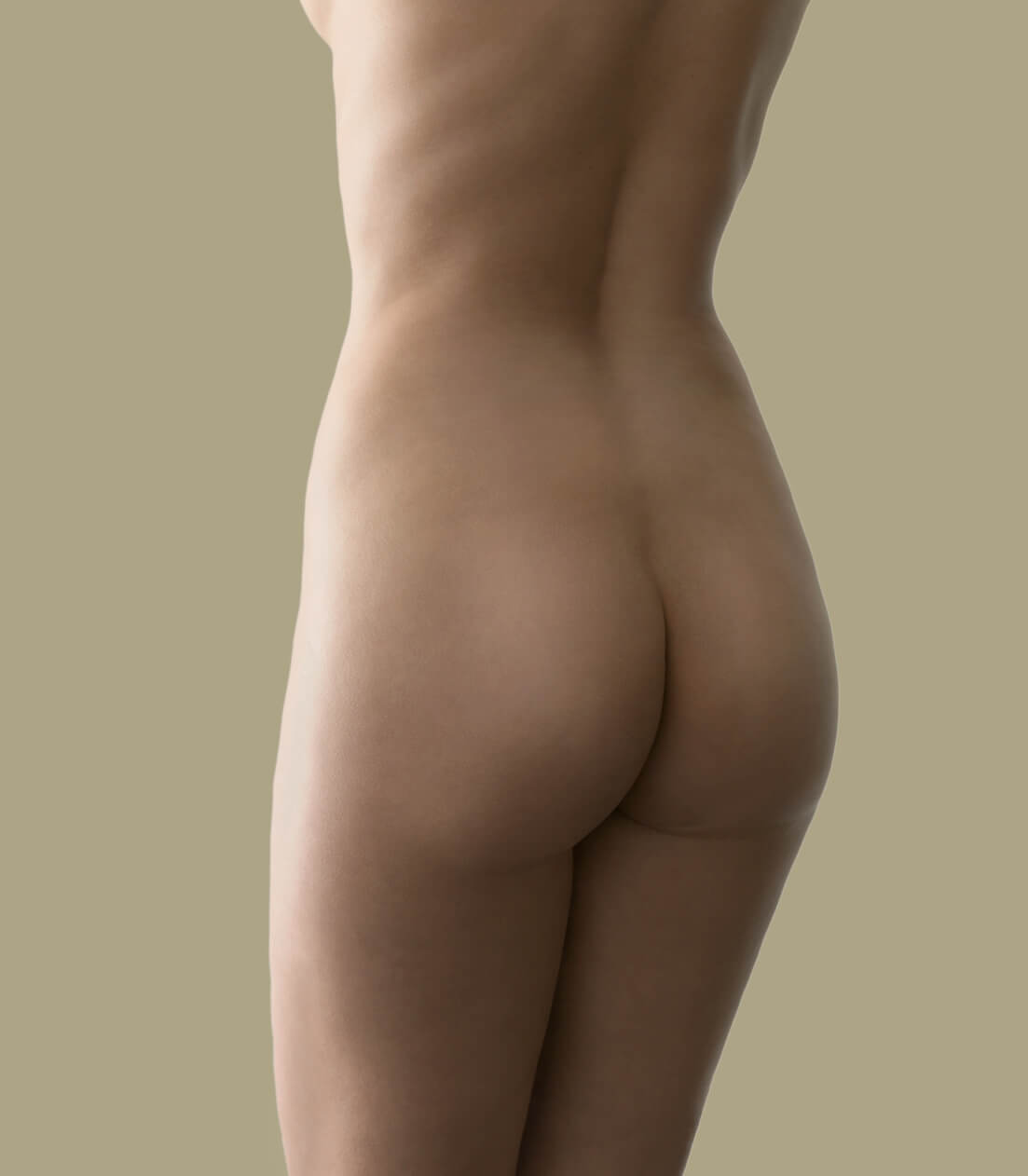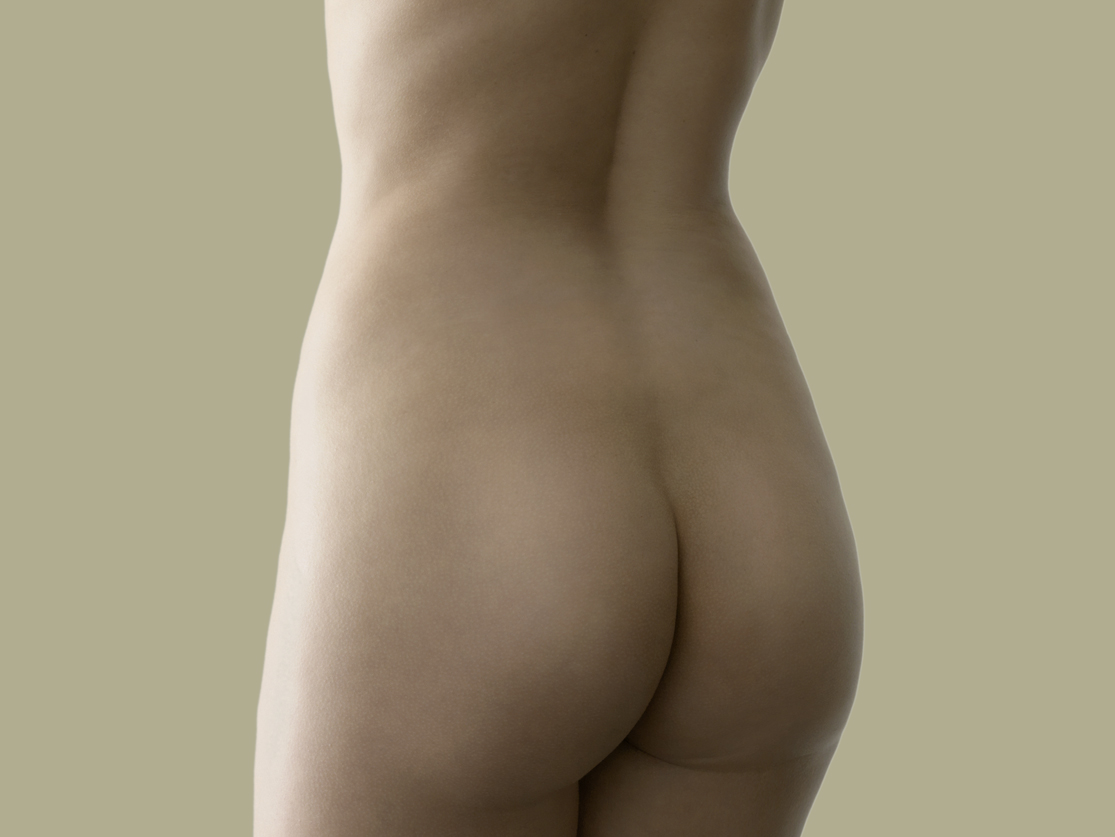
As the name liposuction suggests, liposuction generally refers to the removal of fatty tissue using suction cannulas. Liposuction is a minimally invasive procedure for removing unwanted fat deposits. Even if larger amounts of fat of up to several liters can be removed in one or more sessions, liposuction is not suitable for weight loss. This is only possible through a change in lifestyle with suitable diet and exercise programs.
Also, fatty tissue can only be removed effectively if the skin in this region has sufficient elasticity to adapt to the new contour. In the case of sagging skin without sufficient shrinkage capacity, liposuction can actually worsen the contour. In this case, only a tightening operation can help, in which excess skin is removed along with the fatty tissue.
Considerations
Liposuction may be useful for you if the following conditions apply:
You suffer from excess fatty tissue (fat deposits) in certain areas of your body that appear disproportionate compared to the rest of your body (“problem areas”) and cannot be eliminated through diet and exercise. This is also referred to as “diet-resistant fat”.
There is no or only minimal excess skin in the problem areas and the elasticity of the skin is good. Liposuction only removes fatty tissue, but does not tighten the skin or remove cellulite!
Figure 1: Liposuction on the abdomen and hips during the procedure
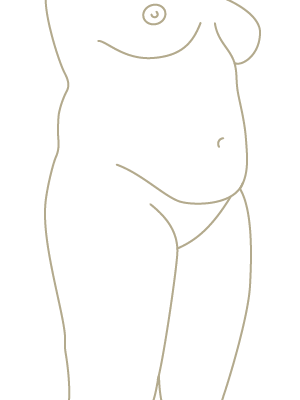
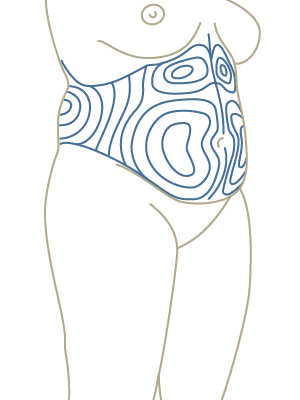
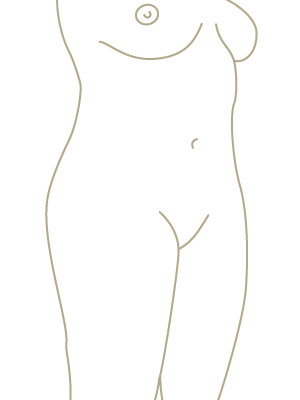
Figure 1 shows the liposuction procedure using a woman as an example. Figure 1a shows the body before liposuction with unwanted fat deposits on the abdomen and hips. The middle picture (1b) shows the areas where fat cells are removed during the operation (blue). The last image (1c) shows the result after liposuction with a natural-looking slimmer body.
Liposuction can be used to remove excess fatty tissue in various areas of the body: Abdominal, hip and lumbar areas, buttocks, saddlebags, thighs, knees, calves, ankles, chest (including gynecomastia in men), arms, neck. Liposuction is equally effective for women and men.
The aim of liposuction is to improve the body contour, not to reduce weight, which is why it is often referred to as “body shaping” or “body sculpturing”. It is often used as a complementary measure in tightening operations, such as tummy tucks (Fig. 2) or breast reductions.
In the presence of very extensive fatty tissue and excess skin (Fig. 2b), it is sometimes advisable to perform a surgical tightening of the abdominal wall in addition to pure liposuction (Fig. 2a), in which not only the excess fatty tissue (blue) but also inelastic, hanging excess skin (gray) can be removed and the dilated abdominal muscles (red) can be tightened (Fig. 2c).
Figure 2: Difference between liposuction on the left and tummy tuck (lipoabdominoplasty) center and right
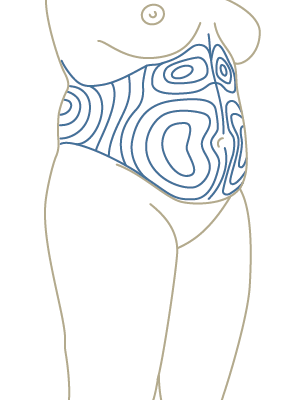
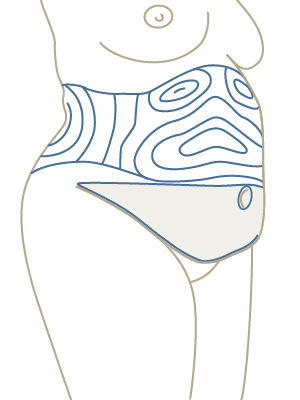
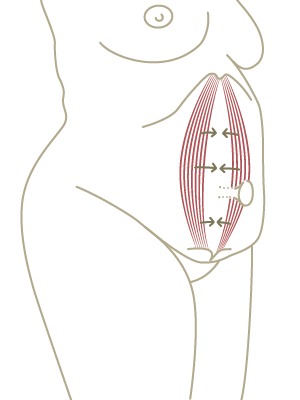
Fat tissue that has been suctioned from regions with excess fat tissue can also be used to fill regions with a lack of fat tissue (lipofilling). Liposuction can also be combined with lipofilling to correct contour irregularities after liposuction by redistributing fatty tissue (liposhifting).
Consultation
Careful planning of the procedure is a prerequisite for successful liposuction. This begins with your consultation at the AARE KLINIK. It is very important for your surgeon to find out your wishes, ideas and expectations regarding the surgical result and your body in order to be able to give you a realistic description of the possibilities and limitations of the operation.
During the physical examination, measurements are taken and digital photographs are taken. These are then used for an objective assessment on the screen and for planning the operation. Of particular importance is the body mass index (BMI), the value of which provides an indication of whether liposuction is appropriate. An individual treatment plan is drawn up together with you, which includes all the important aspects of the operation. The risks and possible complications of the procedure will also be discussed with you. The treatment agreed with you will be documented on a planning sheet.
In order to plan the operation, we need information from you about your medical history (previous illnesses and previous operations), current illnesses (high blood pressure, diabetes, thyroid dysfunction), allergies or intolerances and any medication you may be taking. These are used to assess the risk of surgery and anesthesia. Please bring all current and important medical findings with you to the consultation.
| Liposuction | |
|---|---|
| Duration of surgery | 1 – 4 hours |
| Anesthesia | Local |
| Stay | Outpatient |
| Fit for social life | 1 – 2 weeks |
| Sport | 3 – 4 weeks |
| Costs | from 3’500 CHF |
Procedure
The basis of liposuction is the removal of fatty tissue (Fig. 3) using suction cannulas that are guided through the tissue. These are usually connected to a pump that generates the necessary negative pressure, which is why this technique is also known as assisted liposuction (SAL).
Figure 3: Liposuction procedure
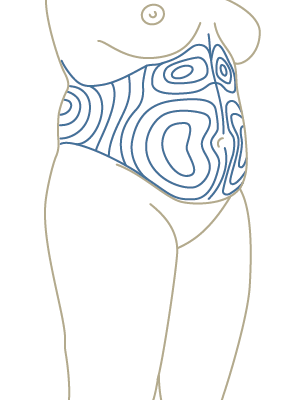
In addition, the cannulas can be driven by an electric motor, which relieves the surgeon of most of the mechanical work. This technique is known as power-assisted liposuction (PAL). A further addition is ultrasound-assisted liposuction (UAL), in which an ultrasound generator produces sound waves above the audible range, which are transmitted to the fatty tissue via special ultrasound probes and “blast” the fat cells.
The released fat can then be removed using suction cannulas (SAL). In our practice, we mainly use the so-called VASER®, a modern ultrasound technology that works very precisely and gently with fine probes. The selective effect of the ultrasound energy on the fat cells (liposelection) protects the surrounding connective tissue as well as the nerves and blood vessels, which promotes rapid and even healing.
This technique is therefore particularly suitable for regions rich in connective tissue, such as the breast (gynecomastia), and regions that are difficult to treat with conventional liposuction.
Risks
Liposuction is one of the most common operations performed in plastic surgery. If correctly indicated and performed, serious complications such as wound infections, wound healing disorders or thromboses are rare. Nevertheless, liposuction also involves risks that vary depending on the patient, the body region treated and the amount of liposuction.
Overall, the risk of complications increases with increasing suction volume, which is why liposuction procedures of more than 4-5 liters should be divided into several operations for the patient’s safety.
Minor complications, which usually heal without consequences, include bruising (hematomas), accumulation of wound fluid (seroma), swelling, temporary loss of sensation and scars. Contour irregularities or depressions (so-called “dents”) may require surgical correction.
You can minimize certain risks by following the surgeon’s instructions and recommendations before and after liposuction.
Preparation
Our aim is to make the liposuction itself as well as the time before and after as pleasant as possible for you. You can support us and yourself by following a few rules of conduct.
For example, it is advisable for smokers to stop smoking 2 weeks before and after the operation, as smoking can impair wound healing. Certain medications that increase the risk of bleeding, such as aspirin, non-steroidal anti-inflammatory drugs as well as homeopathic remedies and some vitamin preparations should be discontinued 2 weeks before the operation. You will receive precise instructions on this from us before your liposuction operation.
Liposuction can usually be performed on an outpatient basis. If this is the case, you should ensure that you can be picked up after the operation and cared for at home for the next 24 hours. Depending on the location and extent, the operation is performed under local anesthesia, possibly with twilight sleep, or general anesthesia. In some cases, inpatient treatment in hospital may be advisable for large-volume liposuction or certain pre-existing conditions.
Day of surgery
At the AARE Clinic, surgery is usually performed on an outpatient or short inpatient basis. In individual cases, with certain pre-existing conditions or for personal reasons, inpatient treatment in a private hospital may be advisable.
During the operation, you will be given various medications to ensure your well-being. Liposuction can often be performed under local anesthesia and sedation, although anesthesia is advantageous in certain cases. For your safety, your heart rate, blood pressure, pulse and blood oxygen level will be monitored during the operation.
At the end of the treatment, you will be fitted with a compression girdle to promote wound healing and even “skin shrinkage”. You will then be taken to the recovery room where you will continue to be monitored until you are fully awake and able to stand up. If you are operated on as an inpatient in hospital, you will be transferred from the recovery room to the ward, where you will remain until the next day.
The pain after liposuction is usually minor and can be compared to a strong muscle ache. It can be treated well with mild, decongestant painkillers, which you can continue to take at home for the first few days.
After outpatient anesthesia, you should be taken home by someone who will look after you continuously for the first 24 hours. This person will receive all the necessary instructions from us for your aftercare as well as rules of conduct in the event of complications or unexpected events. On request, we can offer you short-term inpatient aftercare at the AARE KLINIK by a registered nurse in a single room.
After surgery
It is important to know that the recovery time after each operation varies greatly from person to person. In the first few days after liposuction, you should take it easy physically and, if possible, elevate the treated body region (e.g. arms, legs). Only take the painkillers prescribed to you and no medication containing aspirin. Wear the compression garment permanently and inform us if it is too tight or causes any other problems.
In the first few hours after the procedure, swelling and bruising may occur in the surgical area to varying degrees. Bruising usually disappears within 2-3 weeks, while swelling can persist for several weeks. Most daily activities can be resumed after 10 days or less.
Even after you have left the operating theater, we will continue to look after you and offer you the best possible aftercare. After the operation, follow-up examinations are carried out at regular intervals at the AARE CLINIC and the healing progress is assessed until the final surgical result is achieved. During this time, you will also have the opportunity to tell us about any concerns you may have during the healing process and to ask further questions if you require additional information. Contact us at any time if you need help.
Outcome
The healing process is gradual and it takes several months before the results of the operation can be conclusively assessed. The small scars that have formed at the entry points of the suction cannulas may be reddened or appear darker pigmented for several months, but fade over time and are then usually barely visible.
Figure 4: Liposuction procedure
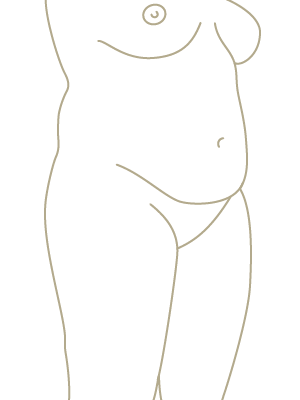
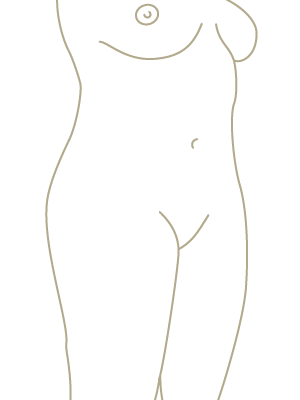
The before and after comparison of liposuction shown in Figure 4 can be achieved in most cases after one treatment (liposuction).
The results of liposuction are generally long-lasting. The removed fat cells do not grow back, so that even if the patient gains weight, the liposuctioned area is less affected. Nevertheless, the result can be influenced by weight gain, ageing, pregnancy and lifestyle.
Costs
The cost of liposuction varies considerably and depends primarily on the extent of the operation, the type of anesthesia (local anesthesia or general anesthesia) and the facility where the operation is performed (AARE KLINK or hospital). An exact cost estimate can therefore only be provided after a personal consultation.
The costs are made up of
- Surgery fee (incl. preliminary consultation and aftercare)
- Anesthesia fee
- Technical service (AARE KLINIK/hospital)
- Hospital stay, if applicable
- Compression girdle
- Medication
- Diagnostics if necessary (laboratory, ECG, etc.)
Meet PD Dr. med. Oliver Scheufler
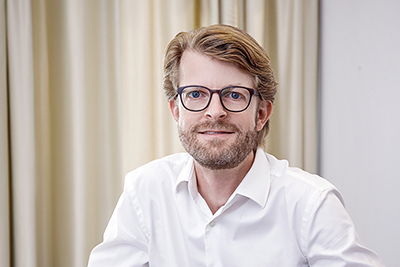
PD Dr. Oliver Scheufler, board certified plastic, reconstructive and aesthetic surgeon and author of this website, is pleased to be at your service for a personal consultation. Besides his main occupation at the AARE KLINIK, Dr. Scheufler is also scientifically active and lectures at the University of Basel. He also was a visiting professor at Duke University (USA). Please do not hesitate to contact him if you wish a professional consultation!
